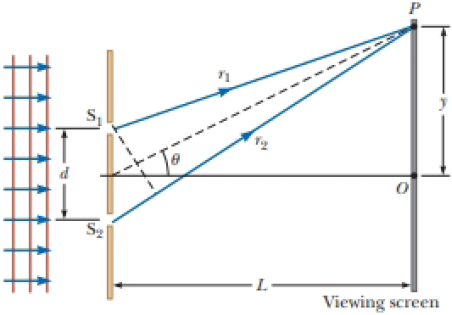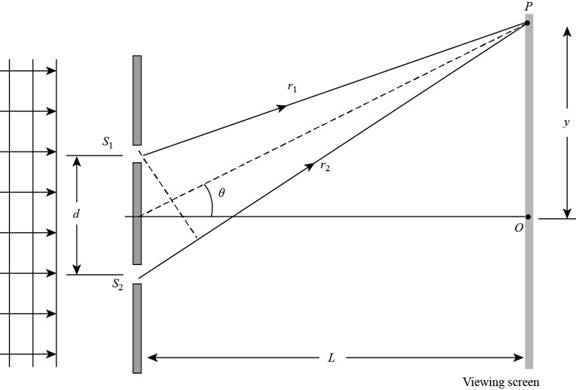
Concept explainers
In Figure P36.10 (not to scale), let L = 1.20 m and d = 0.120 mm and assume the slit system is illuminated with monochromatic 500-nm light. Calculate the phase difference between the two wave fronts arriving at P when (a) θ = 0.500° and (b) y = 5.00 mm. (c) What is the value of θ for which the phase difference is 0.333 rad? (d) What is the value of θ for which the path difference is λ/4?
Figure P36.10

(a)
Answer to Problem 37.18P
Explanation of Solution
Given info: The separation between the slits is
The given diagram is shown below.

Figure 1
The formula to calculate the phase difference is,
Here,
Substitute
Conclusion:
Therefore, the phase difference between the two waves fronts arriving at
(b)
Answer to Problem 37.18P
Explanation of Solution
Given info: The separation between the slits is
The formula to calculate the phase difference is,
Here,
From the right angle triangle
Here,
Substitute
Substitute
Conclusion:
Therefore, the phase difference between the two waves fronts arriving at
(c)
Answer to Problem 37.18P
Explanation of Solution
Given info: The separation between the slits is
The formula to calculate the phase difference is,
Here,
Rearrange the above formula to find
Substitute
Conclusion:
Therefore, the value of
(d)
Answer to Problem 37.18P
Explanation of Solution
Given info: The separation between the slits is
The formula to calculate the phase difference is,
Here,
The path difference is
Substitute
Rearrange the equation (1) to find
Substitute
Conclusion:
Therefore, the value of
Want to see more full solutions like this?
Chapter 37 Solutions
EBK PHYSICS FOR SCIENTISTS AND ENGINEER
- Three point charges of magnitudes Q₁ = +6.0 μС, Q₂ = −7.0 μС, Qз = −13.0 μC are placed on the x-axis at x = 0 cm, x = 40 cm, and x = 120 cm, respectively. What is the force on the Q3 due to the other two charges?arrow_forwardTwo point charges of +30.0 μС and -9.00 μC are separated by a distance of 20.0 cm. What is the intensity of electric field E midway between these two charges?arrow_forwardTwo point charges of +7.00 μС and +10.0 μС are placed inside a cube of edge length 0.100 m. What is the net electric flux due to these charges?arrow_forward
- A conducting hollow sphere has a charge density of σ = 12.2 μC/m². If the sphere has a radius of 25 cm, what net charge is on the sphere?arrow_forward9) Consider an electric field right Ĕ = 21+3ĵ. What is the magnitude of the flux of this field through a 4.0 m² square surface whose corners are located at (x,y,z) = (0, 2, 1), (2, 2, 1), (2, 2, −1), (0, 2, −1)? Ꮓ ту x (0,2,1) Surface 2 Surface (2,2,1) y Ē (0,2,-1) (2,2,-1) 2 xarrow_forwardNo chatgpt pls will upvotearrow_forward
- 2 聯梧桐紀 PAGENIN ERA 5 7 DOG FAMILY puppies C01: Physical Quantities, Units and Measurements 4 A student wanted to measure the diameter of a cylindrical water bottle. Which of the following gives the most accurate measurement? A B CD Take three measurements of the diameter using a rule before finding the average. Take three measurements of the diameter using a digital micrometer screw gauge, resetting to zero before every measurement before finding the average. Take three measurements of the diameter using the digital calipers, resetting to zero before every measurement before finding the average. Take three measurements of the diameter using the digital calipers without resetting to zero before every measurement before finding the average. The resultant force FR acting on an object is given by, FR = ma, where m is the mass of the object in kg and a is the acceleration of the object in m/s². Which unit is equivalent to the unit for force? A B с D kg ms² kg m²s kg m/s² kg m²/s² adt to…arrow_forwardC01: Physical Quantities, Units and Measurements 10 A student uses a rule to measure a thin piece of wire. wire 0 1 cm 2 3 4 5 5 6 7 8 9 10 11 12 13 14 15 (a) State two errors in the student's measurement of the length of wire. [2] The student records the length of the wire as 12.8 cm. [E] The student is asked to measure the thickness of the wire using a pencil and the same rule. Suggest how this can be done as accurately as possible. [4] (b) The student finds out that the density of the wire is 2.7 g/cm³. Express 2.7 g/cm³ in kg/m³. [2] to V emulov or worl? гавтоха [E11 The length of a sheet of plastic is measured using a 15 cm rule. eq 8 5 Imm 1 2 سيلينا 3 3 5 7 8 10 11 12 13 14 L ins 15 sem of beiupe stipib e elun olfastq e riliw bei inebulz A H com al Jari Inemundeni or ezoori (s) re the sheet of plasticarrow_forwardtion v more m C01: Physical Quantities, Units and Measurements 8 The following shows a pencil. (a) pencil sharpened section Describe how you would use a piece of string and a rule to determine the circumference c of the unsharpened section of the pencil. [3] nd pupp e e E (b) The student's value for the circumference c is 2.5 cm. Suggest a source of error in determining the circumference of the pencil. [1] ntit ble Ec et (c) Show the volume V of the unsharpened section of the pencil is V = c²x [3] ΑΠ 55 sn ar 2 72 C: or n/ el D a 7 9 (d) Express the volume VE of the sharpened section of the pencil in terms of c and y. pilasi to leeries to rignal on [3] State any assumptions made. lau besser A student is required to measure the thickness of a ream of 500 sheets of A4 size paper. He is supplied with a plastic rule, a digital micrometer screw gauge and a pair of digital calipers. (a) Choose the instrument that is most suitable to measure the thickness of the ream of paper. Give two…arrow_forward
- 5 C01: Physical Quantities, Units and Measurements 4 Complete the table by stating a suitable instrument for obtaining each of the following lengths to be measured. (6) Length to be measured (a) 12.0 cm (b) 8.880 mm (c) 4.440 cm (d) (e) internal diameter of a test tubes bas thickness of a wire (f) height of a bedroom Suitable Instrument 5 Fill in the blanks by making estimates of each of the following quantities. [5] (a) The thickness of a sheet of paper = mm (b) The time for one heartbeat = (c) The mass of 500 cm3 of water = S g (d) The height of a 4-year-old = 3 (e) The average human reaction time S hoda 6 A student has a stack of 20 identical coins. The following diagram shows the student measuring the height of the stack using a rule.uis en cm 15. 10 7 eye (6) ream of (3) emuntani na mBM (0) 5. stack of 20 coins 0 (b) With his eye at the position shown, the student's measurement of the height of the stack is 6.8 cm. (a) Suggest two reasons why the student's measurement is…arrow_forwardoutside the theory of evolution, the spontaneous emergence of complexity and information from randomness is not recognized in nature. true or falsearrow_forwardNo chatgpt pls will upvotearrow_forward
 Principles of Physics: A Calculus-Based TextPhysicsISBN:9781133104261Author:Raymond A. Serway, John W. JewettPublisher:Cengage Learning
Principles of Physics: A Calculus-Based TextPhysicsISBN:9781133104261Author:Raymond A. Serway, John W. JewettPublisher:Cengage Learning Physics for Scientists and Engineers: Foundations...PhysicsISBN:9781133939146Author:Katz, Debora M.Publisher:Cengage Learning
Physics for Scientists and Engineers: Foundations...PhysicsISBN:9781133939146Author:Katz, Debora M.Publisher:Cengage Learning Physics for Scientists and Engineers with Modern ...PhysicsISBN:9781337553292Author:Raymond A. Serway, John W. JewettPublisher:Cengage Learning
Physics for Scientists and Engineers with Modern ...PhysicsISBN:9781337553292Author:Raymond A. Serway, John W. JewettPublisher:Cengage Learning Physics for Scientists and EngineersPhysicsISBN:9781337553278Author:Raymond A. Serway, John W. JewettPublisher:Cengage Learning
Physics for Scientists and EngineersPhysicsISBN:9781337553278Author:Raymond A. Serway, John W. JewettPublisher:Cengage Learning Glencoe Physics: Principles and Problems, Student...PhysicsISBN:9780078807213Author:Paul W. ZitzewitzPublisher:Glencoe/McGraw-Hill
Glencoe Physics: Principles and Problems, Student...PhysicsISBN:9780078807213Author:Paul W. ZitzewitzPublisher:Glencoe/McGraw-Hill University Physics Volume 3PhysicsISBN:9781938168185Author:William Moebs, Jeff SannyPublisher:OpenStax
University Physics Volume 3PhysicsISBN:9781938168185Author:William Moebs, Jeff SannyPublisher:OpenStax





